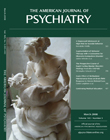Psychotic Symptoms Following Buprenorphine Withdrawal
To The Editor: Buprenorphine reduces the risk of signs and symptoms of opioid withdrawal by its partial agonist property and is thought to potentially lead to a ceiling effect, particularly with respect to euphoria and respiratory depression (1) . Delirium but not psychotic symptoms has been reported following buprenorphine discontinuation (2) . We present a case of a patient who developed psychotic symptoms following buprenorphine withdrawal that disappeared only after its reintroduction.
A 32-year-old man was referred to our department for buprenorphine withdrawal. He had been receiving buprenorphine, 6 mg/day, for 1 year. His medical and psychiatric history included past benzodiazepine and heroin abuse and buprenorphine misuse (12–24 mg/day by intranasal route) with concomitant crack use for 2 years. He reported having a psychotic disorder treated by aripiprazole (15 mg/day) for 12 months, which was discontinued last year by his psychiatrist while he was in jail. On admission, he presented no psychiatric symptoms and was receiving no treatment other than buprenorphine. His physical examination was normal, and a urinary drug screen was negative. We chose to gradually decrease the patient’s buprenorphine dose by 2 mg according to our standardized protocol. Three days after the first dose decrease, symptoms of opioid withdrawal occurred (anxiety, myalgia, sleep disturbance). Hydroxyzine, 150 mg/day, and loxapine, 100 mg/day, resulted in substantial symptom reduction, and buprenorphine was further decreased by 2 mg/day. Three days following this period, visual and auditory hallucinations, paranoid ideation, alternating phases of agitation, and prostration occurred. Loxapine was increased to 200 mg/day, and isolation partially improved the patient’s symptoms. We then decided to reintroduce buprenorphine at 6 mg/day, which is the same dose the patient had been receiving upon admission. The psychotic symptoms remitted in 24 hours. After a follow-up of 8 months, the patient was without psychotic symptoms but continued to receive buprenorphine (6 mg/day).
The antipsychotic effects of buprenorphine were anecdotally reported in 10 patients with psychotic disorders who were not undergoing any antipsychotic treatment at the outset (3) . The frequency of remission of psychotic symptoms following a single buprenorphine dose was as high as 70% and lasted 4 hours on average (3) . Selective k-opioid antagonists have been proposed for the treatment of psychosis (4) , and anti-craving properties have been observed in m-opioid agonism. Buprenorphine’s elimination half-life is biphasic; the second phase can be rather long—up to 40 hours (1) . This seems to be in accordance with the apparition of withdrawal and psychotic symptoms in our case. Thus, we can reasonably hypothesize that the antipsychotic effects of buprenorphine derive from its k-antagonist activity. The discontinuation of buprenorphine resulted in the absence of this beneficial k-antagonistic and potentially antipsychotic effect in our patient. Further clinical data are needed to ascertain whether the discontinuation of buprenorphine may induce psychotic symptoms in individuals with a previous history of psychotic disorders.
1. Davids E, Gastpar M: Buprenorphine in the treatment of opioid dependence. Eur Neuropsychopharmacol 2004; 14:209–216Google Scholar
2. Kaptsan A, Telias D: Delirium due to buprenorphine therapy. Case Rep Clin Pract Rev 2003; 4:182–185Google Scholar
3. Schmauss C, Yassouridis A, Emrich HM: Antipsychotic effect of buprenorphine in schizophrenia. Am J Psychiatry 1987; 144:1340–1342Google Scholar
4. Roth BL, Baner K, Westkaemper R, Siebert D, Rice KC, Steinberg S, Ernsberger P, Rothman RB: Salvinorin A: a potent naturally occurring nonnitrogenous kappa opioid selective agonist. Proc Natl Acad Sci U S A 2002; 99:11934–11939Google Scholar



